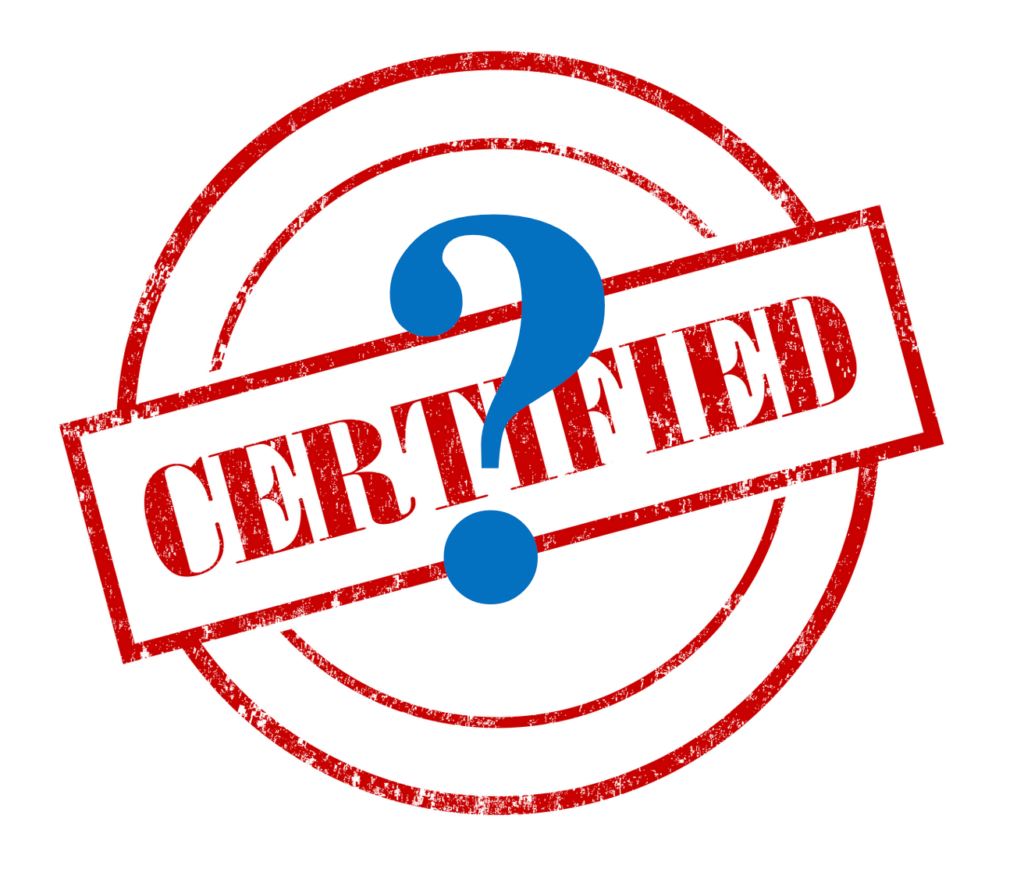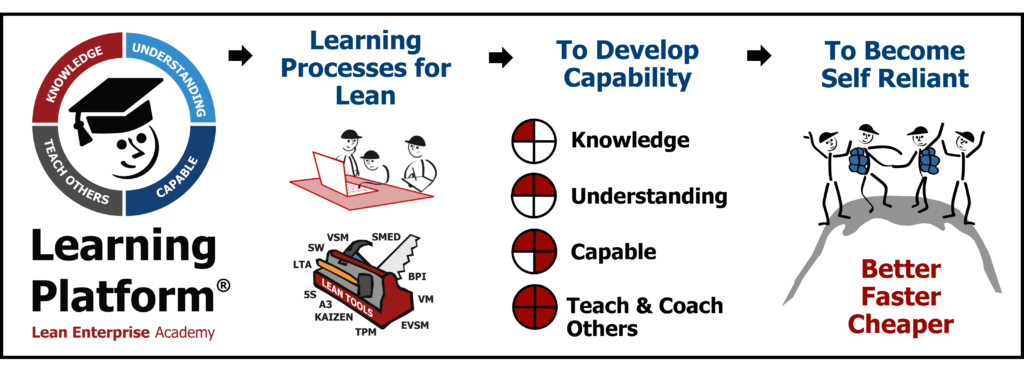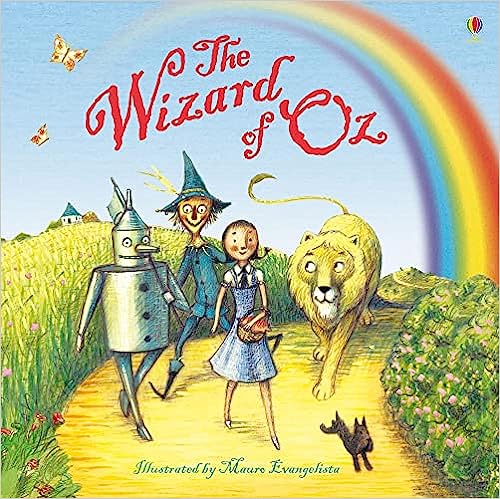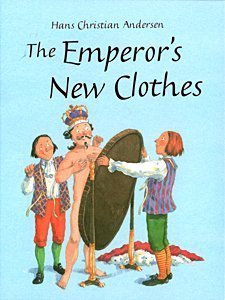Each week we receive emails about lean certification. Do we provide it? Can we provide it? A few weeks ago I took my daughter to a University open day. Several presenters explained how their course gave “credits” towards professional qualifications and some provide certification to professional bodies. As I listened, I couldn’t help ask myself, “Can certification be an effective means of capability development?” What value do lean certifications provide?
What is Certification?
Certification is a formal process that recognizes individuals or organizations for meeting specific standards in a field. It involves assessing and validating knowledge, skills, and qualifications against established criteria set by governing bodies.
Certification typically includes:
- Eligibility Requirements: Prerequisites such as education, work experience, or specific training programs.
- Examination or Assessment: Evaluations through tests, practical demonstrations, or case studies.
- Standardized Criteria: Predefined criteria set by industry experts or professional organizations.
- Certification Body: Reputable organization or governing body responsible for granting certification.
- Validity and Renewal: Certifications often require renewal to ensure individuals stay updated.
Certification is useful when skills are technical. Assessing the skills of an electrician, of a motor mechanic, or a radiologist for example.

Lean Certification
Lean certification validates knowledge and understanding of lean principles, methodologies, and practices. It is offered by professional organizations, training institutes, or consulting firms. The specific requirements and criteria for lean certification can vary depending on the certifying body and the level of certification sought. Some common types of lean certifications include:
- Lean Practitioner: Typically, the entry-level designation and focuses on providing a foundational understanding of lean concepts, tools, and techniques. It may involve coursework, workshops, or examinations to validate knowledge and application of basic lean principles.
- Lean Practitioner/Leader: Usually intended for individuals who have acquired a deeper understanding of lean principles and have demonstrated the ability to lead lean initiatives within their organizations. It often requires practical experience in implementing lean projects and may involve case studies, project assessments, or interviews to evaluate competency.
- Lean Expert/Master: Often offered to individuals with extensive experience and expertise in lean methodologies. It requires a comprehensive understanding of lean principles, advanced problem-solving skills, and the ability to lead and coach others in lean implementation. Achieving this level of certification typically involves a combination of experience, project work, and examination.
For customers, providers argue that there are some potential benefits of lean certification. These may include:
- Validation of Skills: External recognition of lean knowledge and proficiency.
- Career Advancement: Enhanced prospects and opportunities for promotion.
- Enhanced Marketability: Differentiation in a competitive job market.
- Expanded Knowledge and Skill Set: Equipping individuals with a broader skill set.
- Networking Opportunities: Joining a community of certified lean practitioners.
In addition, there are benefits for organisations providing these “qualifications.” Not least the revenue generated from the approach and ongoing contact with programme participants.
Why the Lean Enterprise Academy doesn’t offer Lean Certification.
The Lean Enterprise Academy (LEA) does not offer certification due to several reasons:
- Rigidity: Lean certification may not capture the diverse range of skills and contexts in different industries. Lean skills are not purely technical. They also include a social element. Whilst we can test the ability to use a tool or technique such as calculating a kanban quantity or drawing a spaghetti chart it’s much more complex to certify which type of pull system to use at a given time, with the current level of management capability, with all the other real-world practicalities that need to be considered. Thus, certification may not always capture the diverse range of skills, experiences, and contexts within different industries or organizations. It may overlook innovative or customized approaches to lean implementation.
- Lack of Practical Application: Certification programs may focus more on theoretical knowledge rather than practical skills. Effective implementation requires practice in real-world situations.
- Limited Scope and Depth: Some programs may have a narrow focus, not fully preparing individuals for lean implementation challenges. Some programs may focus on specific aspects of lean, such as process improvement or waste reduction, while others may provide a more comprehensive understanding.
- Cost and Accessibility: Financial costs and limited availability may hinder individuals or organizations from pursuing certification.
- Overemphasis on Certification: Certification should not be the sole measure of competency or success in lean management. Relying too heavily on certification as the primary indicator of expertise may overlook other valuable experiences, practical skills, and continuous learning.
Summary so far
To summarise, we can’t certify the combination of technical and social capability, to apply lean thinking to a situation. We can certify the technical part and so have a certification of completion for levels 1 and 2. But we can’t certify capability (which is what most people want to become) across a range of situations. If we can’t certify this higher-level capability, what can and should we do?
At LEA, we see learning as a skill and capability development journey, not a set criterion to meet. It’s about learning to do and improve. The application of lean is situational, so a one-size-fits-all certification system probably won’t adequately capture the nuances and variations required for successful implementation.
Toyota’s approach: Capability Development
Capability development enhances skills, knowledge, and competencies to achieve goals. It involves learning, coaching, practical experience, and skill development. It goes beyond certification and includes:
- Skill building: Developing practical expertise through hands-on experience and application of knowledge.
- Continuous learning: Emphasizing ongoing improvement, adaptation to change, and acquiring new knowledge.
- Customization and flexibility: Tailoring development to individual and organizational needs, using suitable methods and tools.
Capability development is broader than certification, focusing on diverse skills, continuous learning, and adapting to evolving needs. Certification validates specific knowledge and proficiency within a defined framework.
Main Aspects of Toyota’s Approach
Toyota’s capability development approach is key to its success in implementing lean principles. Here are the main aspects:
- On-the-Job Training: New employees learn through hands-on experience on the shop floor, gaining practical skills and problem-solving abilities from experienced team members.
- Mentorship and Coaching: Employees (new and/or experienced) are paired with mentors who transfer knowledge, provide guidance, and foster continuous learning.
- Continuous Improvement Culture: Toyota promotes a culture of continuous improvement, encouraging employees to identify and solve problems, make suggestions, and contribute to process and system enhancement.
- Teamwork and Collaboration: Toyota emphasizes cross-functional teamwork, promoting effective communication, knowledge sharing, and the development of a broader understanding of the organization.
- Long-Term Employment Perspective: Toyota invests in employees’ long-term development, focusing on continuous learning, growth, and a deep understanding of lean principles.
- Standardized Work and Visual Management: Toyota employs standardized processes and visual management tools for consistency, efficiency, and continuous learning.
These approaches create a culture of learning, collaboration, and improvement. Their emphasis on practical experience, mentorship, and teamwork aligns with their commitment to building the necessary skills for lean implementation.
Unlike some organizations, whilst Toyota uses certification for technical skills, it doesn’t have a formal lean certification program. Instead, they prioritize practical experience, hands-on learning, and problem-solving skills within their unique organizational culture. They believe that true expertise comes from understanding lean principles through continuous learning and experience within Toyota, rather than relying on external certifications.
Are you a Scarecrow, a King or a small boy?
Two short stories illustrate the reasons to be extremely cautious about certifications. In “The Wonderful Wizard of Oz,” the story of the Scarecrow’s Brain teaches that intelligence and wisdom come from within and are more important than external attributes. The Scarecrow accompanies Dorothy on her journey and desires a brain, believing it will make him wise. Despite his perceived lack of brains, he demonstrates intelligence and problem-solving skills throughout their adventure. In the end, it is revealed that the Scarecrow had intelligence all along, and the Wizard explains that he can’t give the Scarecrow a brain, but instead gives him a diploma symbolizing his newfound confidence in his own intellect. It’s not the diploma that demonstrates intelligence.
“The Emperor’s New Clothes” is a popular tale by Hans Christian Andersen. It revolves around an emperor who is obsessed with his appearance. Swindlers convince him that they can make clothes invisible to those who are unfit or foolish. The emperor and his subjects pretend to see the clothes to avoid looking foolish. Eventually, a brave boy speaks the truth, revealing that the emperor is naked. The story warns against vanity, pride, and the importance of honest and critical thinking. It encourages questioning popular opinion, standing up for truth, and being independent thinkers. It cautions against blindly following authority or popular opinion and emphasizes the value of honesty and seeing beyond appearances. You may well be certified but not possess the ability or experience to do and improve. How many “black belts” have never done another “project” after the one that gave them their life-time accreditation?
Conclusions
Of course, everything is situational. In this post, we’ve explained that certification can have some benefits. But this really depends upon what you are trying to do (your purpose) – as an organisation or as an individual. If you are trying to create a group of experts to solve problems for people, then the certification route may be for you. However, we think there is a better way.
The most successful organisations develop problem solving capability in everyone, all team members. Lean really is a journey, not an accreditation to achieve, or an award to stick on the shelf, rarely to be visited again. All the supposed benefits offered by a certification programme can be realised inside an organisation seeking to solve its own situational problems. Getting knowledge and developing understanding are good first steps. But capability development follows on from doing and improving the work to be done in the situation. Going through a standard criteria alone to achieve a certificate or “belt” can rarely achieve such development.
I think Dan Jones best summed up why we don’t do certification. When asked, he said, “I can tell someone is capable when they walk me through their portfolio of A3s.“ The problems they have helped solve, the gaps they have helped close. In other words, to improve you have to do, you have to apply. So, whether you are looking at your organisation or yourself:
- What are your processes for developing capability – at the organisational and individual levels?
- Are they linked to solving your most pressing problems? Can you clearly identify your gaps and your problem(s) to solve?
- Do they follow a PDCA process?
- Are they continuous?
If all you have is belts, as one former senior Toyota manager once said to me, you must remember one thing – “belts aren’t for lean, belts are for trousers!”
If you want to develop the capability of yourself or your team, check out the Lean Learning Platform which provides a range of learning processes and learning materials to use lean thinking and practice.


